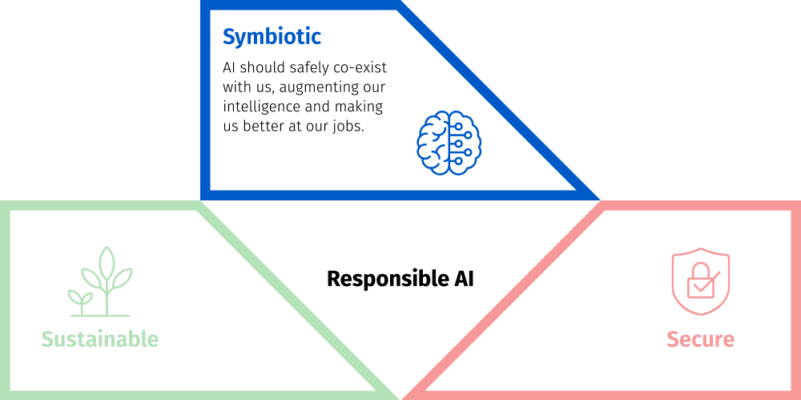There are three tenets of responsible AI — symbiotic, secure and sustainable. In our three-part series, we’ll focus on symbiotic first. Creating a symbiotic relationship between humans and AI systems is important because it allows us to co-exist in harmony rather than strife.
Symbiotic AI is not about replacing humans. It’s about enhancing human capabilities. The goal should be to use AI in ways that augment human intelligence and make us better at our jobs, rather than take anything away from human wisdom and agency.
Symbiotic AI will be enabled through a collaborative interface in which AI systems and humans work together, supplementing each other’s strengths. To foster a harmonious blend of AI and human capabilities, it’s crucial to prioritize proper design, thorough testing and continuous monitoring. This approach to symbiotic AI is at the heart of responsible AI, ensuring that technology not only complements human skills but also produces safe and beneficial results.
Let’s dive into this first pillar of responsible AI to see how the principles of safety, explainability, accountability, transparency and robustness guide us toward ensuring AI technologies augment our human capabilities.

The essential aspects of symbiotic AI
To create a symbiotic AI environment, take these essential trust-building steps:
- Safeguard human interests:Lay the foundation for responsible AI. Make sure AI systems don’t threaten human well-being, either physical or emotional. The critical role of AI in various sectors highlights the importance of preventing unintended consequences. To ensure that AI systems prioritize human safety, incorporate rigorous testing, conduct risk assessments and employ proactive mitigation strategies.
- Unlock the black box: The opaqueness often associated with AI models has sparked concerns about decision-making processes. Responsible AI insists on explainability, where intricate models are demystified, enabling humans to comprehend the rationale behind AI-driven decisions. This fosters accountability and trust, because users can make informed choices based on transparent insights.
- Champion accountability: Just as humans are held accountable for their actions, AI systems also need to bear a sense of responsibility for their outcomes. By holding AI systems accountable, we underscore the shared responsibility between humans and machines. To that end, we should integrate mechanisms that trace back the causes of errors or unintended consequences. This both strengthens the reliability of AI systems and reinforces the ethical standards.
- Illuminate the inner workings: Transparency is a cornerstone of responsible AI. It emphasizes clarity in how AI systems operate and make decisions. When AI’s capabilities and limitations are communicated openly, users can detect any biases or ethical concerns that might arise and make informed choices. Transparency also encourages collaboration between developers, regulators and users, fostering an environment of shared understanding and continuous improvement.
- Make systems more robust: AI systems are exposed to diverse environments and scenarios, making robustness an essential trait. Robust AI exhibits stability and consistent performance across varying conditions, minimizing the risk of unexpected failures. By stress-testing AI models and considering a broad spectrum of scenarios during development, we can deploy systems that can adapt and thrive, even in challenging and unforeseen circumstances.
Charting a path to symbiotic AI
In the best of all worlds, a symbiotic relationship between humans and AI offers organizations a powerful pathway toward lasting transformation. It invites us to embrace a future where we build on each other’s strengths so that together we can unlock the keys to technological advancement and overcome complex challenges.
As we chart the path forward, let’s remember that AI’s potential is maximized when it operates within the bounds of safety, explainability, accountability, transparency and robustness. By weaving these principles into the fabric of AI development, we pave the way for an AI-powered future that both empowers and safeguards humanity.
The journey toward responsible AI is a collective endeavor, requiring the collaboration of technologists, policymakers, ethicists and society at large. Let’s stand united in our commitment to shaping AI systems that amplify human potential while upholding our shared values. Through symbiotic collaboration, we can pursue a brighter and more responsible future — and create a world in which AI and humans coexist harmoniously.
To further your development of responsible AI, be sure to read the other two other blog posts in this series that focus on secure AI and sustainable AI.
Download “The Essential Guide to Symbiotic AI” E-book
Your journey to a symbiotic AI relationship begins with finding the best approach to AI integration